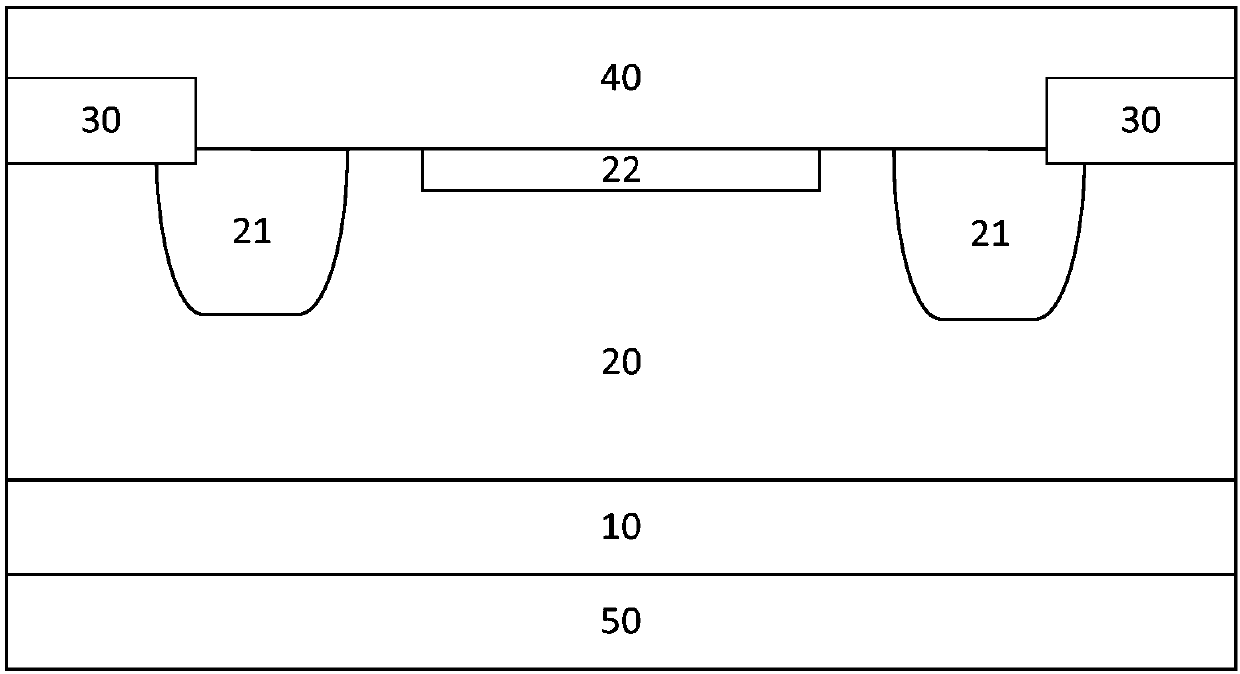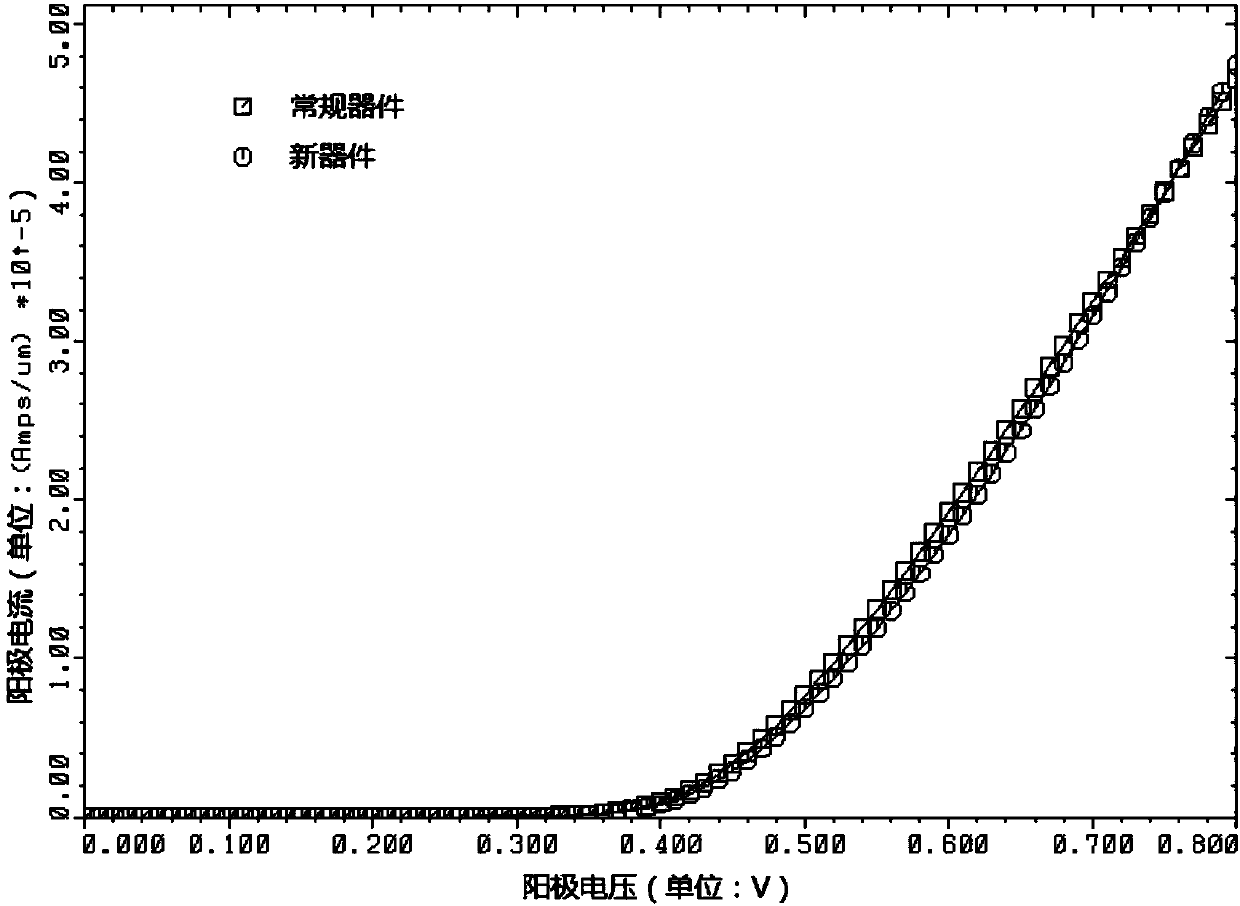Schottky rectifier with surface impurity concentration adjustment region and manufacturing method
A technology of impurity concentration and adjustment area, which is applied in semiconductor/solid-state device manufacturing, semiconductor devices, electrical components, etc., can solve the problems of low leakage current, low forward voltage drop, high impact reliability, etc., and achieve low leakage current , low forward voltage drop, and high impact reliability
- Summary
- Abstract
- Description
- Claims
- Application Information
AI Technical Summary
Problems solved by technology
Method used
Image
Examples
Embodiment 1
[0039] A Schottky rectifier with a surface impurity concentration adjustment region, characterized in that it includes a heavily doped first conductivity type substrate layer 10, a lightly doped first conductivity type epitaxial layer 20, and a second conductivity type guard ring region 21 , the first conductivity type surface impurity concentration adjustment region 22 , the field dielectric layer 30 , the anode metal layer 40 and the cathode metal layer 50 .
[0040] The heavily doped first conductive type substrate layer 10 covers the cathode metal layer 50 .
[0041] The lightly doped first conductive type epitaxial layer 20 covers the heavily doped first conductive type substrate layer 10 .
[0042] Both the guard ring region 21 of the second conductivity type and the surface impurity concentration adjustment region 22 of the first conductivity type cover part of the surface on the epitaxial layer 20 of the lightly doped first conductivity type. The upper surfaces of the...
Embodiment 2
[0048] A method for manufacturing a Schottky rectifier with a surface impurity concentration adjustment region in embodiment 1, is characterized in that it comprises the following steps:
[0049] 1) Covering the lightly doped first conductivity type epitaxial layer 20 on the heavily doped first conductivity type substrate layer 10 .
[0050] 2) Covering the field dielectric layer 30 on the lightly doped epitaxial layer 20 of the first conductivity type.
[0051] 3) Forming a guard ring region 21 of the second conductivity type in a closed ring structure by using the first mask layer. Its annular surrounding part is the active area.
[0052] 4) Etching the field dielectric layer 30 above the active region by using the second mask layer.
[0053] 5) Forming an implantation window on a part of the surface above the active region by using the third mask layer.
[0054] 6) Low-energy implantation of impurities of the first conductivity type into the implantation window formed in...
Embodiment 3
[0066] Using the method in Example 2, a Schottky rectifier with a surface impurity concentration adjustment region is manufactured; wherein, the first conductivity type is N-type, and the second conductivity type is P-type.
[0067] Such as figure 1 As shown, the surface impurity concentration adjustment high-voltage Schottky rectifier produced in this embodiment is characterized in that it includes a heavily doped first conductivity type substrate layer 10, a lightly doped first conductivity type epitaxial layer 20, a second conductivity type The guard ring region 21 , the first conductivity type surface impurity concentration adjustment region 22 , the field dielectric layer 30 , the anode metal layer 40 and the cathode metal layer 50 .
[0068] The N-type epitaxial layer 20 covers the N+ type substrate layer 10 . The N+ type substrate layer 10 is an arsenic impurity substrate with a doping concentration above the 19th power. The N-type epitaxial layer 20 has an impurity c...
PUM
 Login to View More
Login to View More Abstract
Description
Claims
Application Information
 Login to View More
Login to View More - R&D
- Intellectual Property
- Life Sciences
- Materials
- Tech Scout
- Unparalleled Data Quality
- Higher Quality Content
- 60% Fewer Hallucinations
Browse by: Latest US Patents, China's latest patents, Technical Efficacy Thesaurus, Application Domain, Technology Topic, Popular Technical Reports.
© 2025 PatSnap. All rights reserved.Legal|Privacy policy|Modern Slavery Act Transparency Statement|Sitemap|About US| Contact US: help@patsnap.com



